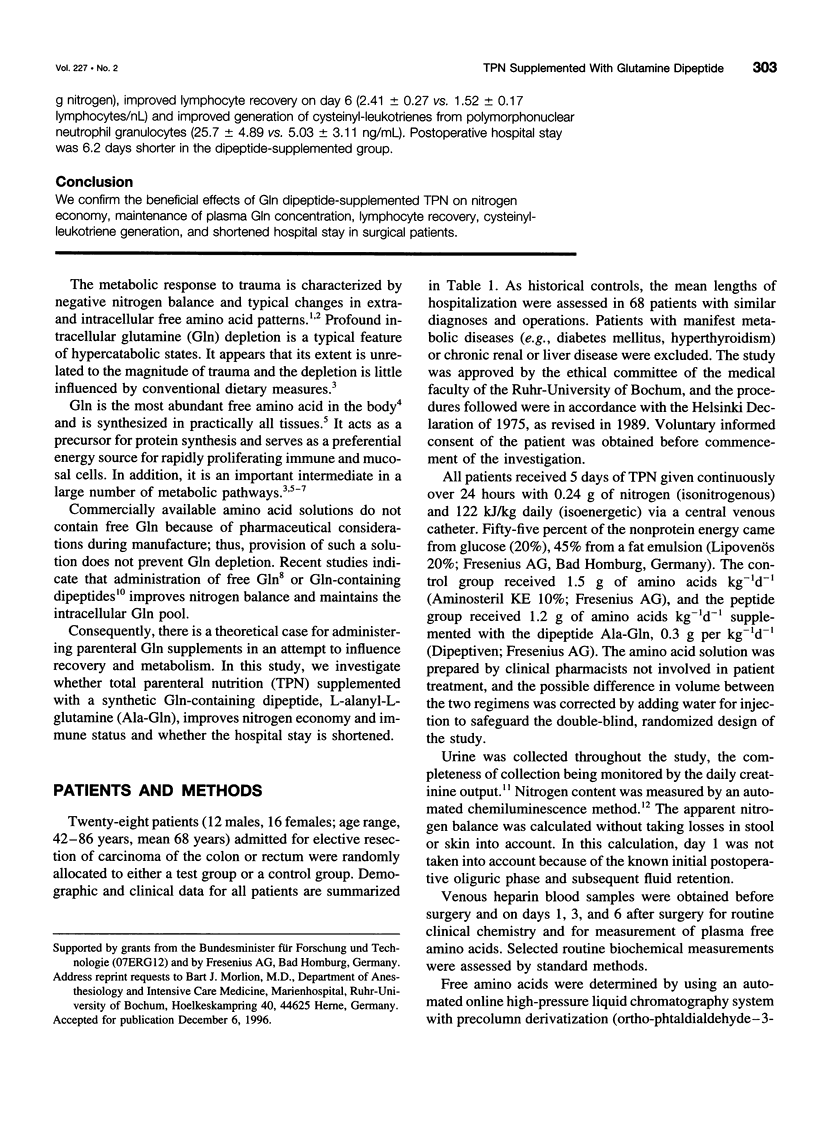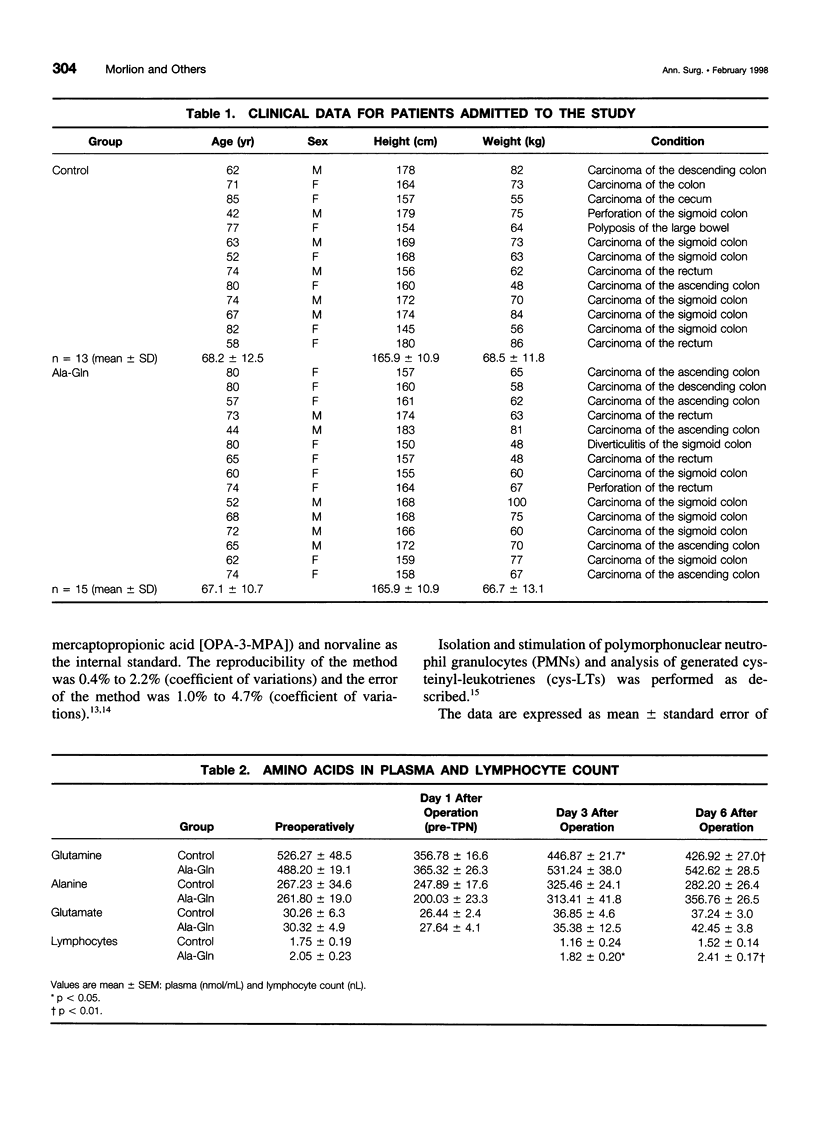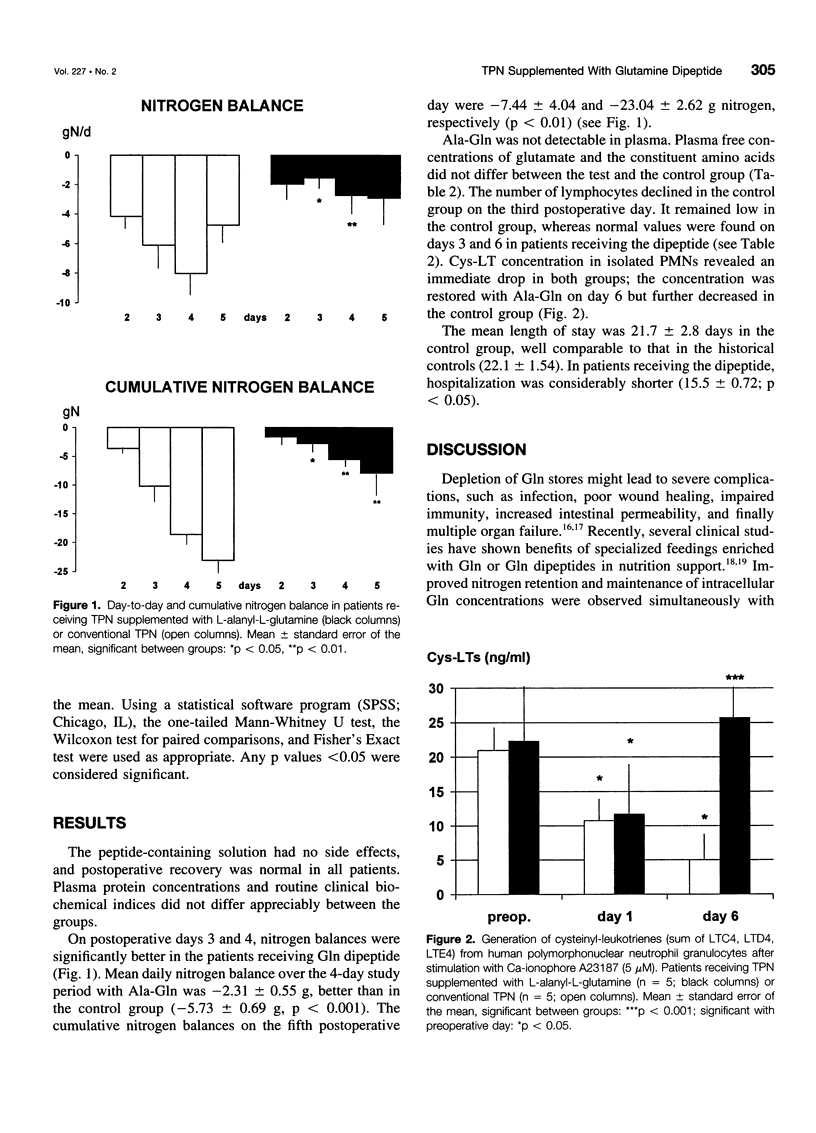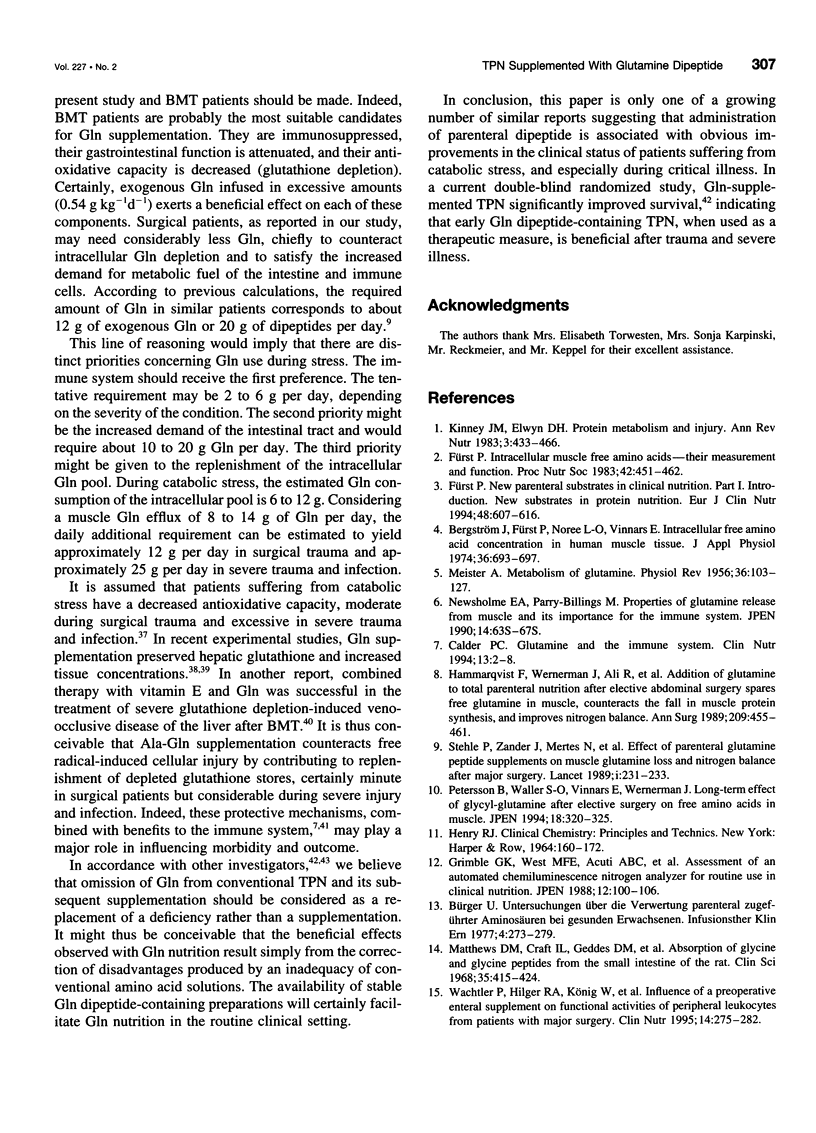Abstract
OBJECTIVE: To assess the efficacy of glutamine (Gln) dipeptide-enriched total parenteral nutrition (TPN) on selected metabolic, immunologic, and clinical variables in surgical patients. SUMMARY BACKGROUND DATA: Depletion of Gln stores might lead to severe clinical complications. Recent studies indicate that the parenteral provision of Gln or Gln-containing dipeptides improves nitrogen balance, maintains the intracellular Gln pool, preserves intestinal permeability and absorption, and shortens hospital stay. METHODS: Twenty-eight patients (age range, 42-86 years, mean 68 years) undergoing elective abdominal surgery were allocated, after randomization, to two groups to receive isonitrogenous (0.24 g nitrogen kg(-1) day(-1)) and isoenergetic (29 kcal/122 kJ kg(-1) day(-1)) TPN over 5 days. Controls received 1.5 g of amino acids kg(-1) day(-1), and the test group received 1.2 g of amino acids and 0.3 g of L-alanyl-L-glutamine (Ala-Gln) kg(-1) day(-1). Venous heparinized blood samples were obtained before surgery and on days 1, 3, and 6 after surgery for routine clinical chemistry and for the measurement of plasma free amino acids. Lymphocytes were counted and the generation of cysteinyl-leukotrienes from polymorphonuclear neutrophil granulocytes was analyzed before surgery and on days 1 and 6 after surgery. Nitrogen balances were calculated postoperatively on days 2, 3, 4, and 5. RESULTS: No side effects or complaints were noted. Patients receiving Gln dipeptide revealed improved nitrogen balances (cumulative balance over 5 days: -7.9 +/- 3.6 vs. -23.0 +/- 2.6 g nitrogen), improved lymphocyte recovery on day 6 (2.41 +/- 0.27 vs. 1.52 +/- 0.17 lymphocytes/nL) and improved generation of cysteinyl-leukotrienes from polymorphonuclear neutrophil granulocytes (25.7 +/- 4.89 vs. 5.03 +/- 3.11 ng/mL). Postoperative hospital stay was 6.2 days shorter in the dipeptide-supplemented group. CONCLUSION: We confirm the beneficial effects of Gln dipeptide-supplemented TPN on nitrogen economy, maintenance of plasma Gln concentration, lymphocyte recovery, cysteinyl-leukotriene generation, and shortened hospital stay in surgical patients.
Full text
PDF






Selected References
These references are in PubMed. This may not be the complete list of references from this article.
- Bergström J., Fürst P., Norée L. O., Vinnars E. Intracellular free amino acid concentration in human muscle tissue. J Appl Physiol. 1974 Jun;36(6):693–697. doi: 10.1152/jappl.1974.36.6.693. [DOI] [PubMed] [Google Scholar]
- Bürger U. Untersuchungen über die Verwertung parenteral zugeführter Aminosäuren bei gesunden Erwachsenen. Infusionsther Klin Ernahr. 1977 Oct;4(5):273–278. [PubMed] [Google Scholar]
- Calder P. C. Glutamine and the immune system. Clin Nutr. 1994 Feb;13(1):2–8. doi: 10.1016/0261-5614(94)90003-5. [DOI] [PubMed] [Google Scholar]
- Darmaun D., Matthews D. E., Bier D. M. Glutamine and glutamate kinetics in humans. Am J Physiol. 1986 Jul;251(1 Pt 1):E117–E126. doi: 10.1152/ajpendo.1986.251.1.E117. [DOI] [PubMed] [Google Scholar]
- Fürst P. Intracellular muscle free amino acids--their measurement and function. Proc Nutr Soc. 1983 Sep;42(3):451–462. doi: 10.1079/pns19830052. [DOI] [PubMed] [Google Scholar]
- Fürst P. New parenteral substrates in clinical nutrition. Part I. Introduction. New substrates in protein nutrition. Eur J Clin Nutr. 1994 Sep;48(9):607–616. [PubMed] [Google Scholar]
- Fürst P., Stehle P. Are intravenous amino acid solutions unbalanced? New Horiz. 1994 May;2(2):215–223. [PubMed] [Google Scholar]
- Fürst P. The role of antioxidants in nutritional support. Proc Nutr Soc. 1996 Nov;55(3):945–961. doi: 10.1079/pns19960091. [DOI] [PubMed] [Google Scholar]
- Grimble G. K., West M. F., Acuti A. B., Rees R. G., Hunjan M. K., Webster J. D., Frost P. G., Silk D. B. Assessment of an automated chemiluminescence nitrogen analyzer for routine use in clinical nutrition. JPEN J Parenter Enteral Nutr. 1988 Jan-Feb;12(1):100–106. doi: 10.1177/0148607188012001100. [DOI] [PubMed] [Google Scholar]
- Hammarqvist F., Wernerman J., Ali R., von der Decken A., Vinnars E. Addition of glutamine to total parenteral nutrition after elective abdominal surgery spares free glutamine in muscle, counteracts the fall in muscle protein synthesis, and improves nitrogen balance. Ann Surg. 1989 Apr;209(4):455–461. doi: 10.1097/00000658-198904000-00011. [DOI] [PMC free article] [PubMed] [Google Scholar]
- Harward T. R., Coe D., Souba W. W., Klingman N., Seeger J. M. Glutamine preserves gut glutathione levels during intestinal ischemia/reperfusion. J Surg Res. 1994 Apr;56(4):351–355. doi: 10.1006/jsre.1994.1054. [DOI] [PubMed] [Google Scholar]
- Hong R. W., Rounds J. D., Helton W. S., Robinson M. K., Wilmore D. W. Glutamine preserves liver glutathione after lethal hepatic injury. Ann Surg. 1992 Feb;215(2):114–119. doi: 10.1097/00000658-199202000-00004. [DOI] [PMC free article] [PubMed] [Google Scholar]
- Häussinger D., Roth E., Lang F., Gerok W. Cellular hydration state: an important determinant of protein catabolism in health and disease. Lancet. 1993 May 22;341(8856):1330–1332. doi: 10.1016/0140-6736(93)90828-5. [DOI] [PubMed] [Google Scholar]
- Kinney J. M., Elwyn D. H. Protein metabolism and injury. Annu Rev Nutr. 1983;3:433–466. doi: 10.1146/annurev.nu.03.070183.002245. [DOI] [PubMed] [Google Scholar]
- Köller M., König W., Brom J., Raulf M., Gross-Weege W., Erbs G., Müller F. E. Generation of leukotrienes from human polymorphonuclear granulocytes of severely burned patients. J Trauma. 1988 Jun;28(6):733–740. doi: 10.1097/00005373-198806000-00002. [DOI] [PubMed] [Google Scholar]
- MEISTER A. Metabolism of glutamine. Physiol Rev. 1956 Jan;36(1):103–127. doi: 10.1152/physrev.1956.36.1.103. [DOI] [PubMed] [Google Scholar]
- MacBurney M., Young L. S., Ziegler T. R., Wilmore D. W. A cost-evaluation of glutamine-supplemented parenteral nutrition in adult bone marrow transplant patients. J Am Diet Assoc. 1994 Nov;94(11):1263–1266. doi: 10.1016/0002-8223(94)92457-0. [DOI] [PubMed] [Google Scholar]
- Matthews D. E., Marano M. A., Campbell R. G. Splanchnic bed utilization of glutamine and glutamic acid in humans. Am J Physiol. 1993 Jun;264(6 Pt 1):E848–E854. doi: 10.1152/ajpendo.1993.264.6.E848. [DOI] [PubMed] [Google Scholar]
- Matthews D. M., Craft I. L., Geddes D. M., Wise I. J., Hyde C. W. Absorption of glycine and glycine peptides from the small intestine of the rat. Clin Sci. 1968 Dec;35(3):415–424. [PubMed] [Google Scholar]
- Nattakom T. V., Charlton A., Wilmore D. W. Use of vitamin E and glutamine in the successful treatment of severe veno-occlusive disease following bone marrow transplantation. Nutr Clin Pract. 1995 Feb;10(1):16–18. doi: 10.1177/011542659501000116. [DOI] [PubMed] [Google Scholar]
- Newsholme E. A., Parry-Billings M. Properties of glutamine release from muscle and its importance for the immune system. JPEN J Parenter Enteral Nutr. 1990 Jul-Aug;14(4 Suppl):63S–67S. doi: 10.1177/014860719001400406. [DOI] [PubMed] [Google Scholar]
- O'Riordain M. G., Fearon K. C., Ross J. A., Rogers P., Falconer J. S., Bartolo D. C., Garden O. J., Carter D. C. Glutamine-supplemented total parenteral nutrition enhances T-lymphocyte response in surgical patients undergoing colorectal resection. Ann Surg. 1994 Aug;220(2):212–221. doi: 10.1097/00000658-199408000-00014. [DOI] [PMC free article] [PubMed] [Google Scholar]
- Pastores S. M., Kvetan V., Katz D. P. Immunomodulatory effects and therapeutic potential of glutamine in the critically ill surgical patient. Nutrition. 1994 Sep-Oct;10(5):385–391. [PubMed] [Google Scholar]
- Petersson B., Waller S. O., Vinnars E., Wernerman J. Long-term effect of glycyl-glutamine after elective surgery on free amino acids in muscle. JPEN J Parenter Enteral Nutr. 1994 Jul-Aug;18(4):320–325. doi: 10.1177/014860719401800407. [DOI] [PubMed] [Google Scholar]
- Ponting G. A., Halliday D., Teale J. D., Sim A. J. Postoperative positive nitrogen balance with intravenous hyponutrition and growth hormone. Lancet. 1988 Feb 27;1(8583):438–440. doi: 10.1016/s0140-6736(88)91232-9. [DOI] [PubMed] [Google Scholar]
- Roig J. C., Meetze W. H., Auestad N., Jasionowski T., Veerman M., McMurray C. A., Neu J. Enteral glutamine supplementation for the very low birthweight infant: plasma amino acid concentrations. J Nutr. 1996 Apr;126(4 Suppl):1115S–1120S. doi: 10.1093/jn/126.suppl_4.1115S. [DOI] [PubMed] [Google Scholar]
- Rouse K., Nwokedi E., Woodliff J. E., Epstein J., Klimberg V. S. Glutamine enhances selectivity of chemotherapy through changes in glutathione metabolism. Ann Surg. 1995 Apr;221(4):420–426. doi: 10.1097/00000658-199504000-00014. [DOI] [PMC free article] [PubMed] [Google Scholar]
- Schloerb P. R., Amare M. Total parenteral nutrition with glutamine in bone marrow transplantation and other clinical applications (a randomized, double-blind study) JPEN J Parenter Enteral Nutr. 1993 Sep-Oct;17(5):407–413. doi: 10.1177/0148607193017005407. [DOI] [PubMed] [Google Scholar]
- Souba W. W. Glutamine: a key substrate for the splanchnic bed. Annu Rev Nutr. 1991;11:285–308. doi: 10.1146/annurev.nu.11.070191.001441. [DOI] [PubMed] [Google Scholar]
- Stehle P., Zander J., Mertes N., Albers S., Puchstein C., Lawin P., Fürst P. Effect of parenteral glutamine peptide supplements on muscle glutamine loss and nitrogen balance after major surgery. Lancet. 1989 Feb 4;1(8632):231–233. doi: 10.1016/s0140-6736(89)91254-3. [DOI] [PubMed] [Google Scholar]
- Vinnars E., Bergstöm J., Fürst P. Influence of the postoperative state on the intracellular free amino acids in human muscle tissue. Ann Surg. 1975 Dec;182(6):665–671. doi: 10.1097/00000658-197512000-00001. [DOI] [PMC free article] [PubMed] [Google Scholar]
- Vinnars E., Holmström B., Schildt B., Odebäck A. C., Fürst P. Metabolic effects of four intravenous nutritional regimens in patients undergoing elective surgery II.--Muscle amino acids and energy-rich phosphates. Clin Nutr. 1983 Apr;2(1):3–11. doi: 10.1016/0261-5614(83)90023-7. [DOI] [PubMed] [Google Scholar]
- Wachtler P., Axel Hilger R., König W., Bauer K. H., Kemen M., Köller M. Influence of a pre-operative enteral supplement on functional activities of peripheral leukocytes from patients with major surgery. Clin Nutr. 1995 Oct;14(5):275–282. doi: 10.1016/s0261-5614(95)80064-6. [DOI] [PubMed] [Google Scholar]
- Wilmore D. W. Catabolic illness. Strategies for enhancing recovery. N Engl J Med. 1991 Sep 5;325(10):695–702. doi: 10.1056/NEJM199109053251005. [DOI] [PubMed] [Google Scholar]
- Young L. S., Bye R., Scheltinga M., Ziegler T. R., Jacobs D. O., Wilmore D. W. Patients receiving glutamine-supplemented intravenous feedings report an improvement in mood. JPEN J Parenter Enteral Nutr. 1993 Sep-Oct;17(5):422–427. doi: 10.1177/0148607193017005422. [DOI] [PubMed] [Google Scholar]
- Ziegler T. R. L-glutamine-enriched parenteral nutrition in catabolic patients. Clin Nutr. 1993 Feb;12(1):65–66. doi: 10.1016/0261-5614(93)90157-y. [DOI] [PubMed] [Google Scholar]
- Ziegler T. R., Young L. S., Benfell K., Scheltinga M., Hortos K., Bye R., Morrow F. D., Jacobs D. O., Smith R. J., Antin J. H. Clinical and metabolic efficacy of glutamine-supplemented parenteral nutrition after bone marrow transplantation. A randomized, double-blind, controlled study. Ann Intern Med. 1992 May 15;116(10):821–828. doi: 10.7326/0003-4819-116-10-821. [DOI] [PubMed] [Google Scholar]


